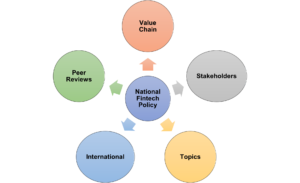By Samuel EDUAM
It is a fact that fintechs in Africa have made significant strides through collaborative efforts of the private and public sector actors in dwindling the gap in access to financial services, especially among the poor and the vulnerable. This fate has been achieved through government policy and regulatory interventions at various levels of engagement. A national fintech policy for that matter refers to a government official position that communicates its intent and support in achieving financial inclusion scale through technology. The policy, which the Ministry of Finance usually owns, is important for dual reasons, namely, for demonstration of government commitment and political will to meet the global financial inclusion agenda such as the Sustainable Development Goals (SDG 1 — Eradicating poverty; SDG 2 — Zero Hunger; SDG 3 — Good Health and Well-Being, SDG 5 — Gender Equality; and SDG 8 — Economic Growth and more Job), while simultaneously providing framework direction and guidance for the ecosystem interested parties.
In developing a national fintech policy or revising the same, governments may consider using the VaSTIP framework. This proposed framework is an acronym for Value Chain, Stakeholders, Topics, International and Peer Review, which provides different perspectives and angles from which the policy may be developed. The framework as illustrated below, further provides micro, macro, local, regional, and global inputs into the development of the policy.

Value chain perspective
This perspective refers to the general activities and processes involved in developing a fintech product or service for financial inclusion consumers. Therefore, this angle of the policy should focus on product development and customer management lifecycles. Remember that fintech broadly represents both financial and non-financial products that target different consumers. Digital lending, Insurance (InsurTech), Agriculture (AgriTech), Education (EduTech), and Healthcare (HealthTech) are a few segments of services offered to consumers for which the national fintech policy must provide insights in terms of how the policy will support and respond to these financial inclusion products.
Stakeholder perspective
The stakeholder angle of the framework begins with the identification of the ecosystem players and their corresponding roles and responsibilities. Policy direction, collaboration and forging partnerships should be the core objective of this perspective considering the diverse players involved in the ecosystem. The policy must provide clarity on the primary and secondary stakeholders as outlined below.

The role of industry associations and civil society organizations (CSOs) must be well treated in the national policy highlighting their advocacy role in championing financial inclusion. Disseminating financial inclusion policy while collating feedback on the same through industry associations is a proven efficient system.
Topical perspective
In the interest of the policy covering contemporary and relevant topics, certain themes must be featured. The topics may have a direct and/or indirect impact on the inclusive finance agenda for the government and other stakeholders. A government’s ability to adequately cover relevant topics in its national policy will motivate stakeholder support in achieving the objective of the policy. An outline of selected topics is mentioned below.
- Gender, Youth and Forcibly Displaced Persons
- Micro, Small and Medium Enterprise finance (MSME)
- Central Bank Digital Currency (CBDC)
- Green/Climate Financing
- Financial Literacy
- Taxation
- Consumer Protection
- AML/CFT&P
- Data Protection and Cybersecurity
As evidence seems to suggest that certain international topics have posed adverse effects on financial inclusion, the growing concern of unintended consequences of AML/CFT must be addressed unambiguously in the national policy document.
International perspective
One important consideration in developing the fintech policy is reviewing international standards and best practices while modifying the requirements to suit the local context. Technology has made the world a global village, and as such, the policy must reflect the same. A few of those international standards include but are not limited to:
- The Bali Fintech Agenda
- UN Principles for Responsible Digital Payments
CGAP, AFI, GSMA, among others, are international technical assistance providers who have diverse and relevant knowledge product documented based on best practices that may be referenced for developing the national fintech policy. The important lesson not to blatantly adopt those knowledge materials without customization to suit the local context cannot be overemphasized.
Peer Review
Country benchmarking review may be a productive exercise to consider when developing a national fintech policy. The reason being that different countries are at different stages of financial inclusion with different lessons learnt so far, and it will be essential to learn from them. Suffice to note that the indicators for comparison need to be similar if not the same to make benchmarking easier and progressive. In the case of Ghana, a good country comparison has been Tanzania considering the comparable legal and regulatory landscape which evidently has translated into an uptake of financial inclusion in both countries.
Conclusion
The VaSTIP framework is only a guide to promote collaborative work in developing a national fintech policy to meet the financial inclusion objectives. Fundamental to this model is the appreciation that a holistic approach to developing the national policy not only sets the right tone at the top but also provides reasonable assurance to consumers that the government intends to meet their financial needs.
Samuel is a Policy and Regulatory Expert with experience in Banking, Fintech, Consulting and International Cooperation.










